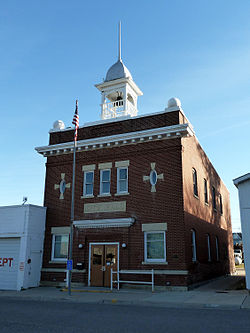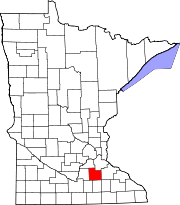- Nerstrand, Minnesota
-
Nerstrand, Minnesota — City — Nerstrand's historic City Hall building, listed on the National Register of Historic Places Location of Nerstrand, Minnesota Coordinates: 44°20′28″N 93°3′59″W / 44.34111°N 93.06639°W Country United States State Minnesota County Rice Area – Total 1.4 sq mi (3.7 km2) – Land 1.4 sq mi (3.7 km2) – Water 0.0 sq mi (0.0 km2) Elevation 1,191 ft (363 m) Population (2010)[1] – Total 295 – Density 164.3/sq mi (63.4/km2) Time zone Central (CST) (UTC-6) – Summer (DST) CDT (UTC-5) ZIP code 55053 Area code(s) 507 FIPS code 27-45196[2] GNIS feature ID 0648482[3] Nerstrand is a small town in Rice County, Minnesota, United States. The population was 295 at the 2010 census.[1]
Minnesota State Highway 246 serves as a main route in the community. Minnesota State Highways 56 and 60 are nearby.
Contents
History
In 1856, Norwegian immigrant Osmund Osmundson moved to Wheeling Township in Rice County. He homesteaded the present site of Nerstrand, building a house and farm, and began to envision a town on the site. In 1877, he built a store on what became the right-of-way for railroad tracks on what is now Main Street. In 1885, the Minnesota and North Western Railroad (later the Chicago Great Western Railway) was constructed, extending from Lyle, Minnesota to St. Paul, and Osmundson platted the town on the line, naming it after his hometown of Nedstrand in Tysvær, Norway.[4]
The town was the center of a significant Norwegian immigrant community, which included people in the surrounding township and county. Some, like Tosten Bonde, who lived just outside the city limits, and Osmundson became state legislators.[5][6][7] Thorstein Veblen, who similarly grew up just outside of the town, became a noted sociologist and economist.
The town incorporated in 1897 and its first city hall, built in the same year. It proved too small within a few years, and a new city hall was built in 1907.[8] The Nerstrand City Hall building was placed on the National Register of Historic Places on April 6, 1982 alongside the Osmund Osmundson House and Tosten Bonde's farmhouse. The Thorstein Veblen Farmstead became a National Historic Landmark.[9] The railroad tracks have since been removed.
Law/Government
Bob Flynn is the mayor.
Geography
According to the United States Census Bureau, the city has a total area of 1.4 square miles (3.6 km2). The town features an elementary school with grades K-5, which is operated as a charter school under state law. There is also a highly rated volunteer fire department.
Nerstrand-Big Woods State Park is located nearby. The Valley Grove Church Building, located nearby, is considered an important historical site, though there are several active churches around the area that are better preserved:
- St. John's United Church of Christ (3 mi southwest)
- Grace Lutheran Church (ELCA) (in town)
- Nerstrand United Methodist Church (in town)
- Gol Lutheran Church (ELCA) (4 mi southeast)
The town was notorious for the nearby Nerstrand Hill, bane of the locomotive engineer, with the steepest grade on the line from St. Paul to Manley Junction, Iowa.
Economy
Throughout its history, the town has acted as a source of services to area farmers. An implement dealer and a full-service grain elevator are still present today carrying on this role. These two businesses together provide over half the employment in Nerstrand.
The business district declined with the advent of the automobile, with most area residents choosing to shop in Northfield which has always been more prominent because of the two colleges located there, or Faribault which is the county seat.
As businesses left, Nerstrand became more of a bedroom community for people working in Northfield, Faribault, or Kenyon. A few nonretail businesses, including a cabinet shop and two specialty construction firms, have come to the community, utilizing what would otherwise be vacant storefront space.
Demographics
As of the census[2] of 2000, there were 233 people, 80 households, and 65 families residing in the city. The population density was 164.3 people per square mile (63.4/km²). There were 82 housing units at an average density of 57.8 per square mile (22.3/km²).
There were 80 households out of which 45.0% had children under the age of 18 living with them, 72.5% were married couples living together, 7.5% had a female householder with no husband present, and 18.8% were non-families. 16.3% of all households were made up of individuals and 10.0% had someone living alone who was 65 years of age or older. The average household size was 2.91 and the average family size was 3.26.
In the city the population was spread out with 33.9% under the age of 18, 4.3% from 18 to 24, 33.9% from 25 to 44, 15.0% from 45 to 64, and 12.9% who were 65 years of age or older. The median age was 33 years. For every 100 females there were 91.0 males. For every 100 females age 18 and over, there were 90.1 males.
The median income for a household in the city was $41,500, and the median income for a family was $50,156. Males had a median income of $32,500 versus $23,333 for females. The per capita income for the city was $15,362. None of the families and 0.4% of the population were living below the poverty line.
Notable natives
Thorstein Veblen (1857–1929), usually characterized as an economist or sociologist, and best known for writing the book The Theory of the Leisure Class (ISBN 0-14-018795-2), lived about a mile northeast of town. His house and farm, The Thorstein Veblen Farmstead, contained several innovations, including what is believed to be the first bucket elevator to be installed on a farm in Rice County. The Thorstein Veblen Farmstead was renovated in 1994 as a historic site and is occasionally open to the public. As of November, 2003, it is for sale.
References
- ^ a b "2010 Census Redistricting Data (Public Law 94-171) Summary File". American FactFinder. United States Census Bureau. http://factfinder2.census.gov/faces/tableservices/jsf/pages/productview.xhtml?pid=DEC_10_PL_GCTPL2.ST13&prodType=table. Retrieved 27 April 2011.
- ^ a b "American FactFinder". United States Census Bureau. http://factfinder.census.gov. Retrieved 2008-01-31.
- ^ "US Board on Geographic Names". United States Geological Survey. 2007-10-25. http://geonames.usgs.gov. Retrieved 2008-01-31.
- ^ Britta Bloomberg, Minnesota Historic Properties Inventory Form, February 1981; copy accessed from Osmund Osmundson House file, State Historic Preservation Office in the Minnesota History Center.
- ^ Britta Bloomberg, Minnesota Historic Properties Inventory Form, February 1981; copy accessed from Bonde, Totsen, Farmhouse file, State Historic Preservation Office in the Minnesota History Center.
- ^ Osmundson, Osmund, Minnesota Legislative Reference Library, Accessed December 9, 2010.
- ^ Johnson, Tosten "T., Tostin", Minnesota Legislative Reference Library, Accessed December 9, 2010.
- ^ Britta Bloomberg, Minnesota Historic Properties Inventory Form, February 1981; copy accessed from Nerstrand City Hall file, State Historic Preservation Office in the Minnesota History Center.
- ^ Nord, Mary Ann (2003). The National Register of Historic Places in Minnesota. Minnesota Historical Society. ISBN 0-87351-448-3.
Bibliography
- Nerstrand Bicentennial Committee, The. 1976. Nerstrand: a history. Nerstrand, Minnesota: The Committee.
- Nerstrand Women’s Club. 1949. History of the Nerstrand Community. [Nerstrand, Minnesota].
Municipalities and communities of Rice County, Minnesota Cities Dennison‡ | Dundas | Faribault | Lonsdale | Morristown | Nerstrand | Northfield‡
Townships Bridgewater | Cannon City | Erin | Forest | Morristown | Northfield | Richland | Shieldsville | Walcott | Warsaw | Webster | Wells | Wheatland | Wheeling
Unincorporated
communitiesCannon City | Little Chicago | Moland‡ | Ruskin | Warsaw
Footnotes ‡This populated place also has portions in an adjacent county or counties
Coordinates: 44°20′31″N 93°04′05″W / 44.34194°N 93.06806°W
Categories:- Populated places in Rice County, Minnesota
- Cities in Minnesota
Wikimedia Foundation. 2010.




